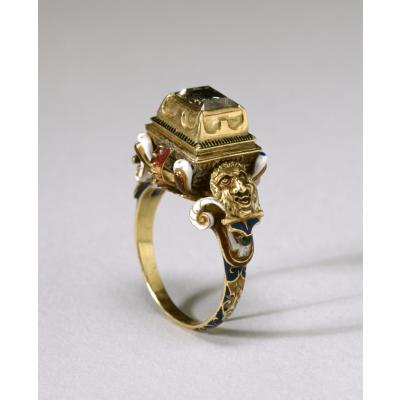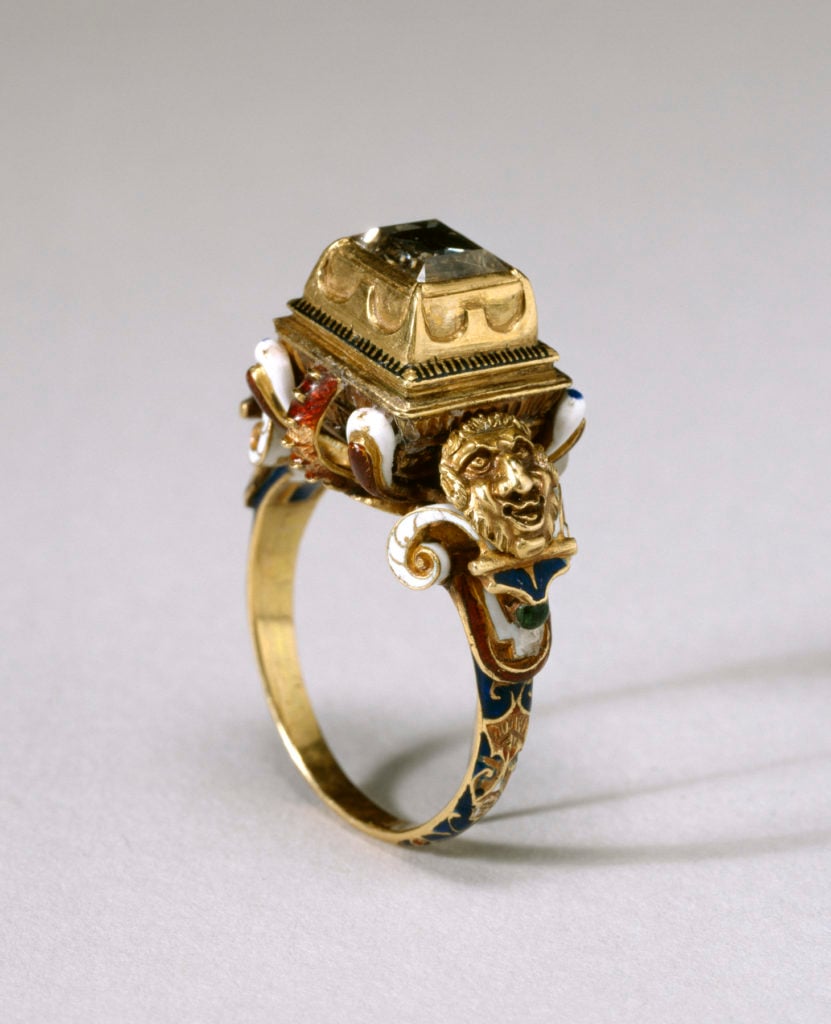
Posted in: Jewelry History
 A table cut diamond surmounts an inverted pyramidal base on the top of this 16th century ring. Intricate enameling decorates the band, leading up to fluted shoulders upon which carved golden masks rest. This antique ring belongs to the Walters Art Museum. Photo credit: Wikimedia Commons.
The Table Cut represents the second diamond cutting technique ever developed. Gemstone cutters primarily employed this technique in Europe. The first diamond cut, the Point Cut, entailed simple grinding and polishing techniques which cleaned up a stone and sharpened the natural points of an octahedral diamond. Subsequently, by sawing off the top of an octahedron, cutters revealed a smooth flat table-like surface.
A table cut diamond surmounts an inverted pyramidal base on the top of this 16th century ring. Intricate enameling decorates the band, leading up to fluted shoulders upon which carved golden masks rest. This antique ring belongs to the Walters Art Museum. Photo credit: Wikimedia Commons.
The Table Cut represents the second diamond cutting technique ever developed. Gemstone cutters primarily employed this technique in Europe. The first diamond cut, the Point Cut, entailed simple grinding and polishing techniques which cleaned up a stone and sharpened the natural points of an octahedral diamond. Subsequently, by sawing off the top of an octahedron, cutters revealed a smooth flat table-like surface.
The Table Cut
Enter the Table Cut. Like the rough diamonds and Point Cut diamonds before it, Table Cut diamonds appear black to the eye. However, by adding a culet to the opposite end, cutters coaxed a little bit of light back to the eye, unlocking a bit of fire from within the stone. Mesmerized by the return of light, cutters began experimenting with ways to increase the effect. By faceting the pavilion at 45-degree angles, these craftsmen achieved significant brilliance. Furthermore, by cutting the crown at 45 degrees, they maximized the effect. (source) This technique acquired the name Full Table Cut. Specifically, the technique involved cutting one point off of a Point Cut diamond. Cutters then added a culet and created four facets on the pavilion. Finally, they added four facets on the crown, as well. (source) Square or rectangle in shape, these Full Table Cut diamonds grew in popularity throughout the Renaissance Period.Variations on a Theme
Of course, diamond cutters continued to develop new techniques and approaches. As a result, several variations on the Table Cut emerged throughout the 1500s and into the 1600s. These include the Mirror Cut and the Double Table Cut. Both remained popular well into the 1800s.The Mirror Cut
Also known as the Spread Table Cut, diamond cutters used the Mirror Cut for diamonds that form as a type of Siamese twin called a macle. These fairly shallow diamonds allowed for a large table with a shallow pavilion. With the large table and bevel style pavilion cuts, the finished diamond offered reflections just like a mirror. Hence, its name.The Double Table Cut
An even more interesting cut, the Double Table cut, emerged during the 1800s. These diamonds, also called Flat Bottom Cut diamonds, featured a table cut above the girdle and an identical cut below. The result, a broad flat diamond perfect for unique innovations in jewelry. One such innovation was the devotionary picture ring. As described in 1865, in the Art Journal, jewelers set a Double Table cut diamond on a ring on a hinge. (source) When lifted, the diamond revealed a hidden portrait in miniature of a loved one, sometimes even a beloved pet.Modern Variations
As diamond cutters developed new techniques, most of these antique table cut diamonds were recut into more modern shapes. As a result, very few examples remain intact. However, these innovation gave way to many beautiful table-inspired cuts, including the Emerald Cut, the French Cut, the Peruzzi Cut, and even the Princess, Baguette, and Modern Brilliant Cuts. (source) Check out this stunning vintage Emerald Cut diamond ring, which features a beautiful and mesmerizing table! ~Angela Magnotti Andrews4 years ago
20 view(s) 